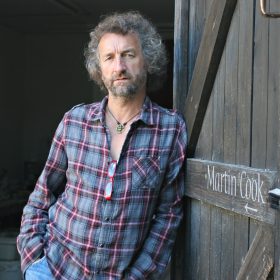Edward Teasdale appeared on the UK craft scene in the 1980’s at a time when ‘creative salvage’, ‘recycling’, and wider environmental issues were having a strong influence on design theory and practice. His forms and construction make common reference to a rationale of both formality and utility while the individuality of each piece comes from interplay of scale, proportion and sculptural detail. In contrast to his pared down and refined approach to design, the wood selected; processes used; and the finishes created do not aim for the perfectly controlled appearance of machine production but accentuate much of the rawness and weathering of the reclaimed natural material used. Teasdale received a National Diploma in Design (Furniture/Interior) in 1965 from Newcastle-upon-Tyne College of Art and a Master of Arts (Art and Design Education) from Manchester Polytechnic in 1984.
‘I was born and raised in England’s ‘Lake District’, in a place where you could feel almost smothered by the proximity of mountains, woodlands and water in all its forms (lakes, tarns, rivers, streams and lots of rain). As I remember it my childhood environment was pretty much devoid of any sophisticated culture. I spent all of my time outdoors building mossy dens in dark pine forests, light filled tree houses in deciduous woodlands and erecting improbable floating structures and bridges to explore the watery landscape. All the time using whatever was available to hand. My eyes and hands were the font of my practical education, noting the characteristics of every fence, stile and farm building as I was allowed to freely roam the largely empty countryside. My aesthetic sensibilities evolved through constant awareness and close examination of trees, rocks, cliffs and the ever changing light and surfaces of hillside, lake and sky. I devoted my adult life to adult education, simply sharing my love of everyday things; natural materials, visual beauty, practical skills and personal creativity. In my midlife crisis I determined I could probably better express my joy of things through making some of my own objects, rather than assisting others whose focus anyway seemed increasingly on academic rather than artistic issues. Now I find I’ve come full circle, sure, I now have knowledge, experience and interests in many things, some sophisticated, but I’m happiest outdoors among nature or in my workshop making useful things out of the elemental materials I stumble across.’ – Edward Teasdale, 2019
Edward exhibited in our Wood exhibition, April 2019 and also In the Grain, in April 2021 at The Scottish Gallery.
















